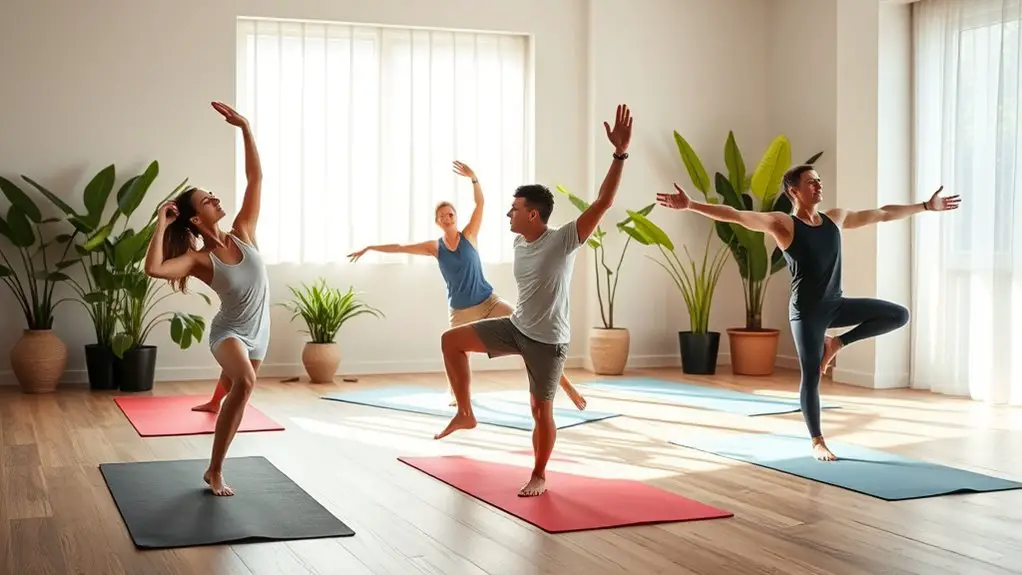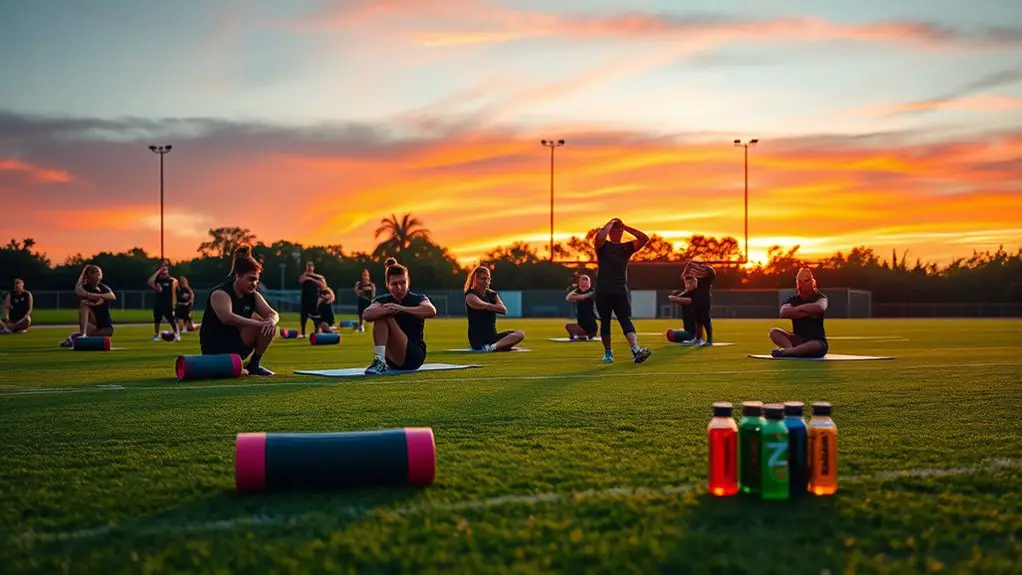To enhance flexibility and prevent injuries, incorporate both dynamic and static stretching into your routine. Start with dynamic stretches like leg swings and arm circles to warm up before activity. After your workout, focus on static stretches, holding each for 20-30 seconds to aid recovery. Don't forget foam rolling and yoga; they can also support flexibility and muscle relaxation. Stick with a consistent stretching practice, and you'll discover even more benefits to boost your routine.
Understanding the Importance of Stretching
Although many people overlook it, stretching is essential for maintaining overall flexibility and mobility. You might not realize it, but regular stretching can release a world of freedom in your body. It improves your range of motion, making everyday movements easier and more enjoyable. When your muscles are limber, you're less likely to feel restricted or experience discomfort during activities you love.
Moreover, stretching helps prevent injuries by preparing your muscles for action. Whether you're chasing a sunset run or dancing freely at a festival, flexibility keeps you agile and ready for spontaneous adventures. You'll find that with increased flexibility, your body feels lighter, and you'll move with more grace. Incorporating rest days into your routine can further enhance your flexibility and overall performance.
Taking a few minutes to stretch daily can transform how you feel in your skin, enhancing your overall sense of well-being. So, why not embrace this simple practice and invite more freedom into your life?
Types of Stretching Techniques
When it comes to stretching, you've got a couple of key techniques to contemplate: static and dynamic stretching. Static stretching can help improve flexibility and reduce muscle tension, while dynamic stretching gets your body warmed up and ready for activity. Understanding these methods can enhance your overall routine and performance.
Static Stretching Benefits
Static stretching offers numerous benefits that enhance flexibility and overall muscle function. When you hold stretches for 15 to 60 seconds, you allow your muscles to relax and lengthen, which can improve your range of motion. This freedom in movement not only feels great but also helps reduce the risk of injuries during physical activities. Plus, static stretching can aid in relieving muscle tension after a workout, promoting recovery. It's a time to connect with your body and really tune into what it needs. Incorporating static stretches into your routine can be a simple yet effective way to release your body's potential, allowing you to move more freely and confidently in your daily life. Embrace the freedom that comes with flexibility!
Dynamic Stretching Techniques
While static stretching plays an essential role in enhancing flexibility, incorporating dynamic stretching techniques can elevate your warm-up routine. These movements, like leg swings and walking lunges, engage your muscles actively, prepping them for action. They boost blood flow and increase your range of motion, helping you feel more liberated in your movements.
Try incorporating dynamic stretches before workouts or sports to enhance performance and prevent injuries. As you perform these techniques, focus on controlled, fluid motions; you're not just stretching, you're energizing your body for what's ahead. Remember, the goal is to feel free and loose, ready to tackle any challenge. Embrace these dynamic stretches, and you'll notice a significant difference in your mobility and overall fitness.
Dynamic Stretching for Warm-Up
Dynamic stretching is an essential part of your warm-up routine, and it can really boost your performance. By incorporating effective dynamic exercises, you'll not only improve your flexibility but also prepare your muscles for action. Let's explore the benefits and some great dynamic stretches you can try. Additionally, dynamic stretching is crucial for enhancing flexibility and range of motion, helping to activate the nervous system and elevate your heart rate before engaging in more intense activity.
Benefits of Dynamic Stretching
When you're gearing up for physical activity, incorporating dynamic stretching into your warm-up routine can greatly enhance your performance. Unlike static stretches, dynamic stretching mimics the movements of your activity, preparing your muscles and joints effectively. This approach increases blood flow, boosts flexibility, and improves your range of motion.
Here's a quick overview of the benefits:
| Benefit | Description |
|---|---|
| Increased Blood Flow | Raises temperature in muscles |
| Enhanced Flexibility | Prepares muscles for action |
| Improved Coordination | Engages the nervous system |
| Reduced Injury Risk | Loosens muscles and joints |
Effective Dynamic Stretching Exercises
To effectively prepare your body for exercise, integrating a series of dynamic stretching exercises into your warm-up is essential. These movements not only increase blood flow but also enhance your range of motion, allowing you to move freely and confidently. Start with leg swings—forward and sideways—to loosen your hips. Next, try walking lunges to engage your core and quads. Arm circles can get your shoulders ready, while high knees and butt kicks elevate your heart rate. Remember to ease into each stretch, focusing on smooth, controlled movements. Incorporating these dynamic stretches helps prevent injuries and sets a positive tone for your workout. So, take a few minutes to enjoy this freedom of movement before diving into your routine!
Static Stretching for Cool Down
After an intense workout, incorporating static stretching into your cool down routine can greatly enhance your flexibility and aid in recovery. This practice allows your muscles to relax and lengthen after exertion, reducing tightness and the risk of injury. Take a moment to focus on each major muscle group, holding stretches for 15 to 30 seconds. Think about your hamstrings, quadriceps, and shoulders—each deserves attention.
It's important to breathe deeply and let go of any tension, embracing the freedom that comes with increased flexibility. You'll find that these stretches not only help your muscles recover but also provide a sense of calm and mindfulness after a vigorous session. As you release each stretch, visualize the stress leaving your body, leaving you refreshed and ready for your next adventure. Make static stretching a non-negotiable part of your cool down, and enjoy the benefits it brings! Stretching after workouts is crucial for promoting better circulation and preventing stiffness.
Foam Rolling: A Complementary Technique
Static stretching is an excellent way to cool down and improve flexibility, but adding foam rolling to your routine can take recovery to the next level. Foam rolling helps release muscle tightness and enhances blood flow, making it a fantastic complement to static stretches. You'll find that it can ease soreness and improve overall range of motion. Incorporating foam rolling into your routine can also enhance overall performance and promote better movement quality.
| Foam Rolling Benefits | How It Helps |
|---|---|
| Releases Muscle Tension | Breaks down knots and adhesions |
| Improves Blood Flow | Increases circulation to muscles |
| Enhances Flexibility | Helps muscles return to ideal length |
Incorporating foam rolling into your routine doesn't have to be complicated. Just spend a few minutes rolling over tight areas after your static stretches. You'll feel more liberated in your movements and ready to tackle your next adventure. So grab a foam roller and enjoy the freedom it brings!
Stretching Routines for Athletes
Athletes often benefit from tailored stretching routines that enhance performance and prevent injuries. By incorporating specific stretches into your training, you can improve flexibility, boost mobility, and reduce muscle tension. Here are three effective routines you should consider:
- Dynamic Warm-Up: Start with movements like leg swings and arm circles to increase blood flow and prepare your muscles for action.
- Targeted Muscle Stretches: Focus on key muscle groups based on your sport. For runners, try calf and hip flexor stretches; for swimmers, emphasize shoulder and chest stretches.
- Post-Activity Stretching: After your workouts, engage in static stretches to promote recovery. Hold each stretch for 20-30 seconds to lengthen your muscles and improve flexibility. Incorporating mobility training into your routine further supports overall performance and reduces injury risk.
Integrating these routines into your regimen can help you feel more agile and ready to tackle your athletic goals. Enjoy the freedom that comes with enhanced flexibility!
Stretching Exercises for Office Workers
If you spend long hours at a desk, incorporating stretching exercises into your routine can greatly alleviate tension and improve your overall well-being. You'll feel more energized and ready to tackle your tasks. Here are some simple yet effective stretches you can do right at your desk:
| Stretch | Duration | Benefits |
|---|---|---|
| Neck Stretch | 15 sec | Reduces neck tension |
| Shoulder Rolls | 30 sec | Relieves shoulder tightness |
| Wrist Stretch | 15 sec | Prevents wrist strain |
| Upper Back Stretch | 30 sec | Improves posture |
| Seated Torso Twist | 30 sec | Increases spinal flexibility |
Incorporating these stretches can also help prevent sprains and strains that may occur from prolonged sitting and poor posture.
Yoga and Its Benefits for Flexibility
While many people associate yoga with relaxation, it's also a powerful tool for enhancing flexibility. Practicing yoga regularly can release your body's potential and give you the freedom to move with ease. Here are three benefits of incorporating yoga into your routine:
- Increased Range of Motion: Yoga poses gently stretch your muscles and joints, helping you achieve a greater range of motion, which can make everyday activities feel effortless.
- Improved Posture: Many yoga poses focus on alignment, helping you develop better posture. This not only enhances flexibility but also reduces strain on your body.
- Mind-Body Connection: Yoga encourages mindfulness, allowing you to tune into your body. This awareness helps you understand your limits, making it easier to push your flexibility safely. Additionally, poses like Child's Pose can help ease muscle tension, further promoting flexibility.
Embrace yoga, and enjoy the freedom of movement it brings, both physically and mentally!
Tips for Safe and Effective Stretching
To guarantee you get the most out of your stretching routine, it's essential to prioritize safety and effectiveness. First, always warm up before you stretch. A few minutes of light cardio can get your blood flowing and prepare your muscles. When you stretch, listen to your body; don't push yourself to the point of pain. Hold each stretch for about 15-30 seconds, breathing deeply to help relax your muscles. Consistency is key, so try to incorporate stretching into your daily routine, even if it's just for a few minutes.
Additionally, integrating bodyweight exercises can further enhance flexibility and mobility, supporting your overall athletic performance. Also, consider your body's unique needs. If you're feeling particularly tight in one area, spend extra time there, but balance it with other muscle groups to maintain overall flexibility. Finally, don't forget to hydrate—keeping your body well-watered supports muscle function and recovery. By following these tips, you'll stretch safely and effectively, giving you the freedom to move with ease.
Frequently Asked Questions
How Often Should I Stretch Each Week for Best Results?
You should aim to stretch at least three to four times a week for the best results. Consistency helps your body adapt, improve flexibility, and reduce the risk of injury, giving you more freedom to move.
Can Stretching Help Alleviate Muscle Soreness After Workouts?
Yes, stretching can definitely help ease muscle soreness after workouts. It increases blood flow to muscles, promoting recovery. Just remember to listen to your body and incorporate gentle stretches post-exercise for the best results.
Is It Safe to Stretch With an Injury?
Imagine your body like a delicate instrument; stretching with an injury can sometimes cause more harm than good. It's best to listen to your body, consult a professional, and prioritize healing before resuming your routine.
What Age Is It Appropriate to Start Stretching Regularly?
You can start stretching regularly at any age, but introducing it during childhood or adolescence is ideal. It promotes flexibility and body awareness, helping you move freely and reduce the risk of injuries as you grow.
How Long Should I Hold Each Stretch for Optimal Benefits?
You wouldn't want to rush freedom, right? Ideally, hold each stretch for 15 to 30 seconds. This sweet spot helps your muscles relax and lengthen, releasing the potential for enhanced flexibility and reduced injury risks. Enjoy the journey!




